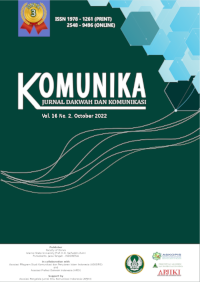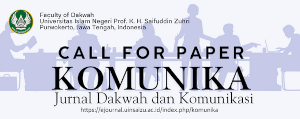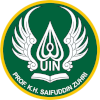Postmillenial Netizens' Reception of Da'wah Messages on Social Media
DOI:
https://doi.org/10.24090/komunika.v16i2.6428Keywords:
Reception, Postmillenial netizen, Da’wah messages, Social MediaAbstract
Content of proselytizing at receptions differently. Da'wah content on social media is a negotiation process. Da'wah's content shows the potential position of postmillennial netizens as active meaning. They are free to choose proselytizing content. This research uses a qualitative method with an interpretive approach. The data were analyzed to find the postmillennial netizens' reception pattern. This research was conducted at State Islamic Religious universities in South Sulawesi Province. There are three groups in the reception of proselytizing content on social media. Firstly, netizen postmillennial oppositional position. In this group, postmillennial netizens are inconsistent in particular groups but watch a variety of messages and preachers. In this group, netizens examine religious concepts from multiple sources. The second negotiated position of this group is postmillenial netizens fanatical on certain mubaligh but still, put tabayyun on certain mubaligh. A third hegemonic position is a militant group without putting forward the principle of tabayyun. However, in this study, social media is a medium that offers various types of preaching and different proselytizing messages. So, some netizens experience the hybridization of proselytizing messages. But some netizens do not experience hybridization of religious understanding because they only watch certain mubaligh.Downloads
References
Ahyar, M. (2017). Islamic Clicktivism; Internet, Democracy and Contemporary Islamist Activism in Surakarta. Studia Islamika, 24(3), 435–468.
APJII. (2020). Laporan Survei Internet APJII 2019 – 2020. Asosiasi Penyelenggara Jasa Internet Indonesia, 2020, 1–146.
Badan Pusat Statistik. (2019). Statistik Telekomunikasi Indonesia 2019. Badan Pusat Statistik.
Badan Pusat Statistik. (2020). Berita Resmi Statistik (Issue 27). Badan Pusat Statistik.
Badan Pusat Statistik. (2021). The Indonesian Population Census 2020 (Issue February). Badan Pusat Statistik.
Bahrisy, A. (2018). Konsep Kelembutan Dakwah dalam Alquran. UIN Sunan Ampel Surabaya.
Bamualim, C. S. (2018). Kaum Muda Muslim Milenial: Konservatisme, Hibridasi Identitas, dan Tantangan Radikalisme (Issue March 2018). Center for The Study of Religion and Culture (CSRC) dan Pusat Kajian Agama dan Budaya UIN Syarif Hidayatullah Jakarta.
Craswell, J. W. (2015). Penelitian Kualitatif dan Desain Riset. Pustaka Pelajar.
Day, S. B. (2005). Hubungan Politik dan Dakwah. Mediator: Jurnal Komunikasi, 6(1), 7–16. https://doi.org/10.29313/mediator.v6i1.1171
During, S. (1999). Stuart Hall: Encoding, Decoding. In The Cultural Studies Reader. Routledge.
Eriyanto. (2008). Analisis Wacana; Pengantar Analisis Teks Media. LKiS Pelangi Aksara.
Fairclough, N. (1995). Critical Discourse Analysis; The Critical Study of Language. In Critical Discourse Analysis: The Critical Study of Language. Longman.
Fitriani, A. (2018). Analisis Isi Pesan Dakwah Ustaz Hanan Attaki Dalam Akun Youtube Pemuda Hijrah. UIN Syarif Hidayatullah Jakarta.
Halimatusa’diyah, I. (2020). Beragama di Dunia Maya; Media Sosial dan Pandangan Keagamaan di Indonesia. Monografi-Merit Indonesia, 1(1).
Hall, S. (1980). Culture, Media, Language. Hutchinson.
Hasan, N. (2018). Literatur Keislaman Generasi Milenial; Transmisi, Apropriasi, dan Kontestasi. Pascasarjana UIN Sunan Kalijaga Press.
Iswanto, A. (2018). Membaca Kecenderungan Pemikiran Islam Generasi Milenial Indonesia. Harmoni, 17(1), 172–179.
Junaeni, R. (2021). Dakwah Visual Media Sosial Ustaz Hanan Attaki melalui Shift di Instagram. UIN Sunan Gunung Djati.
Kementerian Pendidikan dan Kebudayaan. (2020). Pedoman Penyelenggaraan Belajar Dari Rumah Dalam Masa Darurat Penyebaran Corona Virus Disease (Covid-19). In Surat Edaran Nomor 15 Tahun 2O2O (Issue 021, pp. 1–20).
Kominfo. (2017). Survey Penggunaan TIK 2017.
Latief, H. (2010). Youth, Mosques and Islamic Activism; Islamic Source Books in University-based Halaqah. Kultur, 5(1), 63–88.
Mathieu, D. (2015). The Continued Relevance of Reception Analysis in the Age of Social Media. Trípodos, 0(36), 13–34.
Miller, D., Costa, E., Haynes, N., & McDonald, T. (2016). How the World Changed Social Media. In How the World Changed Social Media. UCL Press. https://doi.org/10.14324/111.9781910634493
Mubarak, D. F. (2019). Konstruksi Teks Pemberitaan Calon Gubernur Sulsel Periode 2018 Pada Harian Fajar (Studi Pada Berita Tentang Penjaringan Cagub). Jurnal Diskursus Islam, 7(1), 1–20.
Muniruddin, M. (2019). Humor Dan Komunikasi Dakwah Pengembangan Masyarakat Islam. Jurnal Komunika Islamika : Jurnal Ilmu Komunikasi Dan Kajian Islam, 5(2), 95–107. https://doi.org/10.37064/jki.v5i2.3998
Mutmainnah, N. N., & Arifuddin. (2021). Seni Budaya sebagai Media Dakwah. Mercusuar, 2(1), 30–42.
Muvid, M. B., & Aliyah, N. D. (2020). Konsep Tasawuf Wasathiyah Di Tengah Arus Modernitas Revolusi Industri 4.0; Telaah Atas Pemikiran Tasawuf Modern Hamka dan Nasaruddin Umar. Tribakti: Jurnal Pemikiran Keislaman, 31(1), 169–186.
Pertiwi, P. (2018). Pesan Dakwah Ustadz Adi Hidayat dan Persepsi Mad’u di masjid Ad-Du’a Kelurahan Way Halim Kota Bandar Lampung. In Universitas. UIN Raden Intan Lampung.
Rahmawati, T. (2018). Analisis Semiotik Gaya Retorika Dakwah Oki Setiana Dewi dalam Kisah Detik-Detik Wafatnya Rasulullah saw pada Media Youtube. UIN Sunan Ampel Surabaya.
Saifuddin, L. H. (2019). Moderasi Beragama. Badan Litbang dan Diklat Kementerian Agama RI.
SE No.15 Kemendikbud. (2020). Surat Edaran Sekretaris Jenderal Kemendikbud.
Siahaan. (1991). Komunikasi; Pemahaman dan penerapannya. BPK Gunung Mulia.
Storey, J. (1996). What is Cultural Studies? A Reader. St Martin’s Press Inc. https://doi.org/10.4324/9780203356616
Supena, I. (2013). Filsafat Ilmu Dakwah; Perspektif Filsafat Ilmu Sosial. Ombak.
Thoharoh, D. (2010). Strategi dakwah M. Quraish Shihab dalam Buku Membumikan Al-Qur’an. IAIN Walisongo Semarang.
Ummah, A. H. (2020). Dakwah Digital dan Generasi Milenial. Tasâmuh, 18, 54–78.
We Are Social & Hootsuite. (2020). Indonesia Digital Report 2020. In Global Digital Insights. https://datareportal.com/reports/digital-2020-global-digital-overview
Weng, H. W. (2018). The Art of Da’wah; Social Media, Visual Persuasion and the Islamist Propagation of Felix Siauw. Indonesia and the Malay World, 46(134), 61–79.
Yin, R. K. (2008). Studi Kasus; Desain dan Metode. RajaGrafindo Persada.
Zaid, B. (2014). Audience Reception Analysis of Moroccan Public Service Broadcasting. Middle East Journal of Culture and Communication, 7(3), 284–309.
Zulhazmi, A. Z. (2018). Mendulang Suara Generasi Milenial Muslim; Citra Ketua Umum PPP M. Romahurmuziy di Media Sosial. Shahih, 3(2), 163–174.

Downloads
Published
Issue
Section
License
Copyright (c) 2022 Muhammad Qadaruddin, Wahyuddin Bakri

This work is licensed under a Creative Commons Attribution-ShareAlike 4.0 International License.
Authors who publish with this journal agree to the following terms:
- Authors retain copyright and grant the journal right of first publication with the work simultaneously licensed under a Creative Commons Attribution-ShareAlike 4.0 International License that allows others to share the work with an acknowledgement of the work's authorship and initial publication in this journal.
- Authors are able to enter into separate, additional contractual arrangements for the non-exclusive distribution of the journal's published version of the work (e.g., post it to an institutional repository or publish it in a book), with an acknowledgement of its initial publication in this journal.
- Authors are permitted and encouraged to post their work online (e.g., in institutional repositories or on their website) prior to and during the submission process, as it can lead to productive exchanges, as well as earlier and greater citation of published work (See The Effect of Open Access).




























